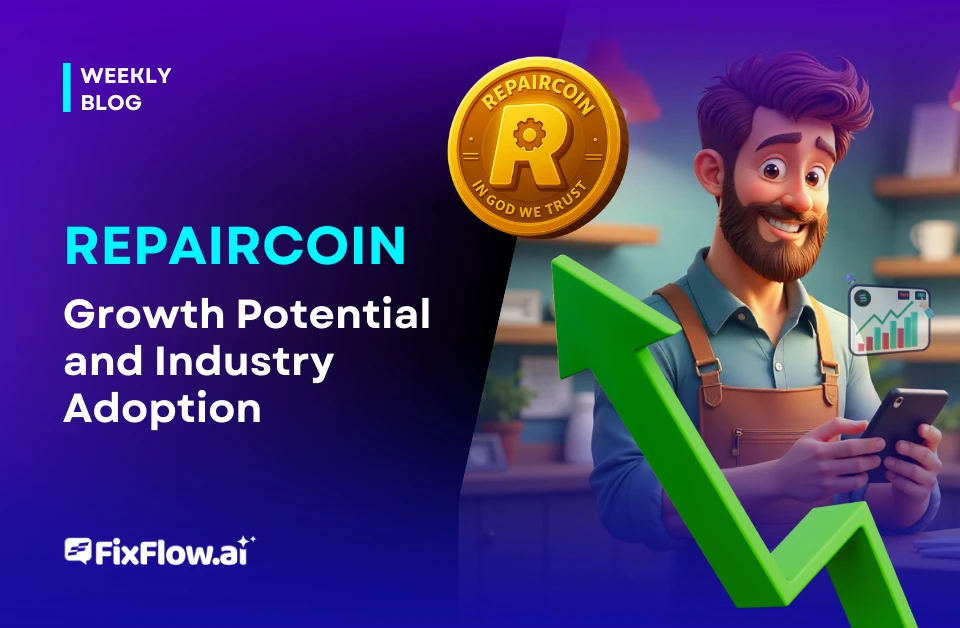RepairCoin Growth Potential and Industry Adoption
RepairCoin is positioning itself as a specialized cryptocurrency for the $400 billion global repair services market. You’ll find it’s gaining traction through strategic partnerships with repair networks, tool manufacturers, and parts suppliers. The token offers practical applications in the automotive and electronics sectors while providing lower transaction fees and immutable service records. Its deflationary model and integration potential with IoT devices suggest substantial growth as the ecosystem continues expanding beyond traditional payment systems.
Market Analysis: RepairCoin’s Position in the Cryptocurrency Ecosystem
While thousands of cryptocurrencies compete for attention in today’s digital economy, RepairCoin has carved out a distinctive niche by focusing exclusively on the repair service industry. Unlike general-purpose cryptocurrencies, RepairCoin addresses specific pain points for repair professionals and their customers.
Current cryptocurrency adoption trends show specialized tokens gaining traction faster than generic alternatives. With the repair services market valued at over $400 billion globally, even modest penetration represents significant growth potential. Blockchain in service industries continues to evolve beyond simple payments, with RepairCoin positioned at this intersection of practical utility and technological innovation.
You’ll find RepairCoin’s targeted approach particularly valuable as service providers increasingly seek digital payment solutions that reduce costs while enhancing transaction security and customer trust, key factors driving its competitive advantage in today’s expanding crypto ecosystem.
Strategic Partnerships Driving Enterprise Adoption
RepairCoin’s market position gains substantial momentum through its strategic alliance-building efforts. You’ll notice how the currency’s collaboration with established repair networks creates seamless fintech and service integration, allowing businesses to adopt blockchain payments without disrupting existing workflows.
When you examine successful case studies, it’s clear that RepairCoin’s partnerships with tool manufacturers and parts suppliers form a complete ecosystem that benefits all participants. This industry disruption through crypto is happening organically as repair businesses recognize immediate cost savings and operational improvements.
Your repair business can leverage these partnerships too, gaining access to a growing network of suppliers and customers already familiar with the platform. These strategic relationships are transforming scattered repair services into an interconnected digital marketplace with RepairCoin at its center.
Real-World Applications Across Manufacturing and Service Industries
Beyond theoretical potential, RepairCoin has established tangible applications throughout manufacturing and service ecosystems. You’ll find repair coin crypto facilitating seamless transactions between parts suppliers and repair shops, eliminating traditional payment delays and reducing costs.
In the automotive sector, specialized garages are implementing decentralized payment systems powered by RepairCoin to manage customer billing, parts procurement, and warranty claims. Meanwhile, electronics repair chains are integrating the token into their point-of-sale systems, offering customers instant payments and loyalty rewards.
Service industries have embraced RepairCoin’s functionality for managing contractor payments across multiple locations, with the blockchain providing immutable service records that simplify warranty verification and parts authenticity. This practical utility is driving adoption beyond crypto enthusiasts into mainstream business operations.
Token Economics and Sustainability Model
Three key pillars form the foundation of RepairCoin’s economic structure. First, the deflationary token model guarantees long-term value preservation through controlled supply and strategic burning mechanisms. You’ll benefit from this design as adoption increases repair coin industry use across service centers worldwide.
Second, transaction fees are considerably lower than traditional payment systems, creating immediate cost advantages for both businesses and customers. This efficiency directly supports repair ecosystems while maintaining network security.
Finally, token-based loyalty programs create a self-reinforcing adoption cycle. When you participate, you’re not just making payments but building equity within a repair community that rewards continued engagement.
This balanced economic approach addresses volatility concerns while creating sustainable growth pathways that align incentives for all stakeholders in the repair marketplace.
Future Growth Trajectories and Expansion Opportunities
The evolving landscape of digital payments presents multiple expansion vectors for RepairCoin in the coming years. You’ll likely witness repair coin growth in both established and emerging markets as repair businesses recognize its value proposition, lower transaction fees, and enhanced security through blockchain technology.
Strategic partnerships with major repair service networks and parts suppliers could accelerate repair coin adoption exponentially. Cross-border expansion represents another significant opportunity, allowing international repair transactions without currency conversion hurdles.
As smart contracts become more sophisticated, RepairCoin could integrate automated warranty processing and parts authentication, creating entirely new utility dimensions. The integration with IoT devices in smart homes and vehicles might ultimately position RepairCoin as the default payment solution for automated maintenance systems, expanding far beyond its original market scope.
Frequently Asked Questions
How Does RepairCoin Handle Transaction Disputes Between Customers and Repair Shops?
When handling transaction disputes, RepairCoin utilizes a multi-layer resolution system. You’ll find that it employs smart contracts that establish clear service agreements upfront. If you have an issue, you can access their built-in escrow mechanism that holds funds until services meet agreed standards. They’ve also implemented a decentralized arbitration process where community validators help resolve complex disputes. For additional protection, you’ll appreciate their immutable transaction records that provide evidence during disagreements.
What Security Measures Protect RepairCoin From Hacking or Theft?
RepairCoin employs multiple security measures to protect your funds. You’ll benefit from its blockchain’s encryption and distributed ledger technology, making unauthorized access nearly impossible. Two-factor authentication secures your wallet, while cold storage options keep major holdings offline. Smart contracts guarantee transparent transactions, and regular security audits identify vulnerabilities before they’re exploited. The network’s consensus mechanism prevents double-spending and other common attacks that plague digital currencies.
Is RepairCoin Mining Environmentally Sustainable Compared to Bitcoin?
Yes, RepairCoin is more environmentally sustainable than Bitcoin. Unlike Bitcoin’s energy-intensive proof-of-work system, you’ll find RepairCoin uses a proof-of-stake consensus mechanism that consumes drastically less electricity. You don’t need power-hungry mining rigs to participate. This eco-friendly approach means you’re making a smaller carbon footprint when using or investing in RepairCoin, while still maintaining blockchain security and transaction validation capabilities.
How Can Small Repair Businesses Implement RepairCoin With Minimal Technical Expertise?
You can implement RepairCoin easily with minimal technical expertise. Start with user-friendly wallets like TrustWallet or MetaMask that offer simple interfaces. Many payment processors now offer plug-and-play solutions specifically for small businesses. You’ll find ready-made QR code systems that integrate with your existing point-of-sale setup. Consider joining online communities where experienced users can guide you through the setup process with step-by-step tutorials.
What Happens to RepairCoin if Cryptocurrency Regulations Become More Restrictive?
If cryptocurrency regulations tighten, you’ll face several challenges. Your RepairCoin operations might require compliance updates, increasing costs, and administrative burdens. You’d likely need KYC procedures and reporting systems. Geographic restrictions could limit your customer base. However, you can prepare by establishing legal counsel, creating contingency plans, and maintaining transparent operations. Remember that well-designed cryptocurrencies often adapt to regulatory changes rather than disappearing entirely.







